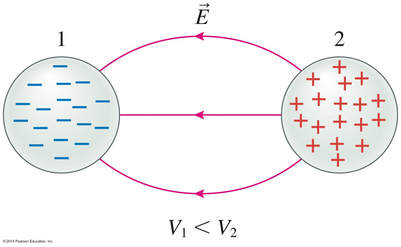Electric Potential Energy
Similar to mass placed in a gravitational field, there is potential energy stored when a charge is placed in an electric field. Mass placed in a gravitational field wants to be in its most relaxed state (the ground). That is the lowest potential energy it can have. A positive charge in an electric filed wants to be as far away from postive charges as it can be, and as close to negative charges. When we talk about a positive charge in an electric field, it can have negative potential energy. This means it is close to a negatively charged particle. Take the simulation below and drag several positive charges in a vertical line on the left side. Then drag the same number of negative charges in a vertical line on the right. Check the "Voltage" box and drag a sensor out in between the two lines. Notice that the sensor represents a positive charge, so it always wants to move towards the negative charges. The negative charges represent the position where a positive charge would have the lowest possible potential energy, so that is what it would like to do.
Potential Difference and Voltage

You have probably heard the term "Voltage" before, but it can be tricky to understand. Voltage is a measure of the electromotive force (emf) or the difference in electric potential measured in, you guessed it, Volts (V). Now the next logical question is "What is electric potential?" Electric potential represents the amount of energy it would take to bring an elementary charge to a specific location within an electric field. This is where things get abstract. This does not give us a value for the energy, but rather an idea of what electric potential energy a charge would have. So voltage, electromotive force (emf) or potential difference would tell us about how much energy a particle would gain or lose by moving from one point to another. The particle would have an electric potential value telling us about the energy it would have at that position, and then when it moves to a different position, the electric potential changes (this is the voltage). So a large voltage would mean a positive charge would have a great change in electric potential energy. If you look at the charges you assembled above, you should be able to see the bright red areas represent very high electric potential, and the bright blue areas represent very low (negative) electric potentials. There is a very large potential difference from positive to negative charges separated by a distance.
What you need to know:
For the scope of our AP Physics class, what you need to know is that a large voltage/emf/potential difference means a particle while lose a lot of electric potential energy getting from a point of high voltage to low voltage. The term grounded means that point has a potential difference of zero. Like gravitational potential, we get to choose where our zero height reference point is from, so we can choose what we define to be zero electric potential (grounded). However, unlike gravitational potential, a charge can go to negative voltage and would like to if possible. That would be its most relaxed state.
John Travoltage
|
While this is a fun, and somewhat goofy, simulation to the right, it does a nice job of demonstrating the importance of voltage and potential difference. As Travoltage dances, he gains extra electrons, those electrons spread throughout the body giving him a net negative charge. The electrons would like to go to the lowest possible potential, so when the hand goes near the door knob (which is grounded), the electrons flow through his arm to the lower potential Earth. The more charge he has, the greater the distance to the door knob will be before the potential difference becomes too great.
|
|

